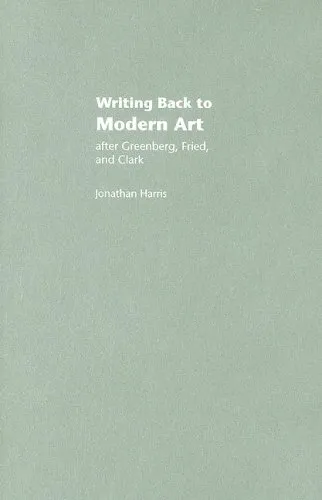Writing Back to Modern Art: After Greenberg, Fried and Clark
4.5
Reviews from our users

You Can Ask your questions from this book's AI after Login
Each download or ask from book AI costs 2 points. To earn more free points, please visit the Points Guide Page and complete some valuable actions.Introduction to "Writing Back to Modern Art: After Greenberg, Fried and Clark"
Modern art has long sat at the center of cultural discourse, inspiring awe and controversy in equal measure. In "Writing Back to Modern Art: After Greenberg, Fried and Clark," Jonathan Harris revisits the significant theoretical frameworks established by art critics Clement Greenberg, Michael Fried, and T.J. Clark. Through insightful critique and nuanced exploration, the book bridges past analyses with contemporary perspectives, urging art aficionados, scholars, and readers alike to rethink the evolution of criticism within the world of modern art.
Highlighted by rigorous academic scrutiny and evocative storytelling, the book tracks the journey of modernist art from elitism to democratization while interrogating the validity of its most rigid conventions. By engaging directly with the works of Greenberg, Fried, and Clark, Jonathan Harris opens an intellectual dialogue that redefines our conceptual tools for understanding modern art in the 21st century.
Detailed Summary of the Book
"Writing Back to Modern Art" begins by revisiting the critical contributions of Clement Greenberg, whose formalist approach defined much of the discourse surrounding abstract and modernist art in the mid-20th century. Harris evaluates Greenberg's arguments for the purity, autonomy, and flatness of modern art, linking them to broader societal ideals yet critiquing their exclusionary tendencies. Through detailed analysis, the book questions Greenberg’s rigid frameworks while proposing alternative evaluations.
Michael Fried's concept of theatricality and absorption is explored in depth as Harris investigates its implications on the perception of art objects. Fried's strong distinction between 'art' and 'non-art' is deconstructed, and the author builds bridges to a more inclusive contextual understanding of modern art practices.
The final part of the book critiques T.J. Clark’s Marxist art history approach, noting its ability to capture art's socio-political dimensions while addressing its limitations in dealing with aesthetic nuances. Harris balances Clark’s critical methodologies with broader interpretations suited to address the diverse cultural landscape of contemporary art.
Through these dialogues, Harris's work doesn’t merely critique but seeks to expand the intellectual palate, offering new ways of engaging with modernist and postmodernist artworks. By synthesizing these divergent critical approaches, "Writing Back to Modern Art" delivers fresh insights that resonate with readers both academically and personally.
Key Takeaways
- Art criticism evolves as cultural and societal contexts shift, demanding an ongoing reassessment of foundational theories.
- Greenberg's focus on formalism offers valuable insights but risks marginalizing important socio-political elements of art.
- Fried's concepts of theatricality and absorption remain relevant but require reconciliation with the diversity of modern perspectives.
- Clark’s Marxist approach highlights the intersection of art and politics, yet must adapt to encompass aesthetic freedom in contemporary contexts.
- A holistic engagement with modern art requires the blending of formal, social, and aesthetic approaches.
Famous Quotes from the Book
"Art criticism is not static; it speaks, evolves, and grows as the world around it changes."
"To understand modern art is to understand modernity itself—not as a monolith, but as a mosaic of shifting ideals and contradictions."
"Criticism is an act of love, not destruction. It seeks to further illuminate, not to extinguish or confine."
Why This Book Matters
Jonathan Harris’s "Writing Back to Modern Art" is not just another book about art criticism—it is an intellectual awakening. In an era where art is increasingly globalized, fragmented, and pluralistic, this book reminds us of the importance of revisiting foundational critiques to understand how they hold up in contemporary settings.
Whether you are an academic, an artist, or an admirer of modern art, "Writing Back to Modern Art" equips you with tools to critique, appreciate, and engage deeply with the art that defines our era. It transcends the boundaries of traditional criticism, advocating for a more inclusive, dynamic dialogue about art and its role in society. By reinvigorating discussions around the works of Greenberg, Fried, and Clark, Harris has produced a book that matters profoundly—for those who seek to understand art critically and emotionally.
Free Direct Download
You Can Download this book after Login
Accessing books through legal platforms and public libraries not only supports the rights of authors and publishers but also contributes to the sustainability of reading culture. Before downloading, please take a moment to consider these options.
Find this book on other platforms:
WorldCat helps you find books in libraries worldwide.
See ratings, reviews, and discussions on Goodreads.
Find and buy rare or used books on AbeBooks.
1138
بازدید4.5
امتیاز50
نظر98%
رضایتReviews:
4.5
Based on 0 users review
"کیفیت چاپ عالی بود، خیلی راضیام"
Questions & Answers
Ask questions about this book or help others by answering
No questions yet. Be the first to ask!


